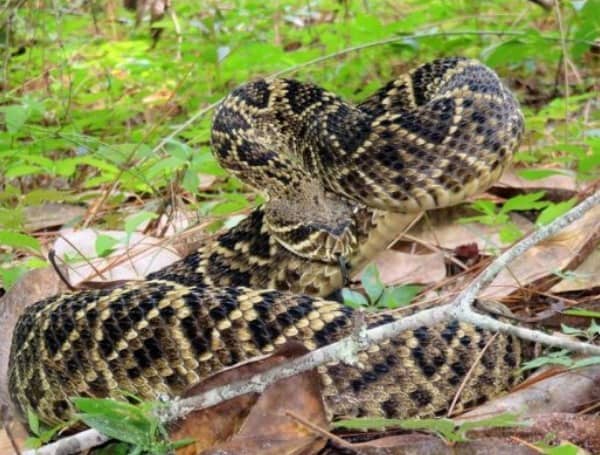A Florida woman is recovering after being bitten by a venomous snake on May 19 in North Port.
According to NBC2, Sierra Lynn, 21, was walking at Myakkahatchee Creek Environmental Park when a snake, believed to be an Eastern Diamondback Rattlesnake, bit her.
Lynn was rushed to the hospital following the bite. Her boyfriend, Derrick Hunter, called Lynn’s recovery a “miracle.”
“We didn’t think she was going to be back around on Saturday, the day after, but she’s a warrior, and she fought through, and absolute miracles happen,” Hunter told NBC2.
In the news: Video: Deputies In Florida Rescue A Hawk Being Strangled By A Snake In The Road
According to NBC2, Lynn has been continuing to recover at the hospital. Lynn’s family and Hunter advise those walking on trails to remain vigilant.
The Florida Fish and Wildlife Conservation Commission says out of the state’s 44 snake species, six are venomous, including the Eastern Diamondback Rattlesnake.
Florida Snakes
Florida is home to a wide variety of snakes, both venomous and non-venomous. The most common venomous snakes in Florida are the Eastern diamondback rattlesnake, the timber rattlesnake, and the water moccasin.
The most common non-venomous snakes in Florida are the black racer, the coachwhip, and the redbelly snake.
It is important to be able to identify the snakes in your area so that you can avoid them if possible. If you are bitten by a snake, seek medical attention immediately.
In the news: Florida Spring Brings Bats, Bears, Snakes, And More
Here are some tips for identifying snakes in Florida:
- Venomous snakes have fangs that are used to inject venom into their prey. Non-venomous snakes do not have fangs.
- Venomous snakes are typically larger than non-venomous snakes.
- Venomous snakes typically have a triangular head, while non-venomous snakes have a more rounded head.
- Venomous snakes typically have a pattern on their skin, while non-venomous snakes do not have a pattern.
Here are some tips for avoiding snakes:
- Wear boots and long pants when hiking or camping in areas where snakes are present.
- Be aware of your surroundings and be on the lookout for snakes.
- If you see a snake, give it plenty of space.
- Do not approach a snake, even if it seems to be asleep.
- If you are bitten by a snake, seek medical attention immediately.
There are 46 species of snakes in Florida, of which 12 are venomous. The most common venomous snakes in Florida are the Eastern diamondback rattlesnake, the timber rattlesnake, and the water moccasin.
In the news: FWC Highlights Three Native Florida Snakes On World Snake Day
The non-venomous snakes in Florida include:
- Black Racers (Coluber)
- Coachwhips (Masticophis)
- Red Belly Snakes (Storeria)
- Crayfish Snakes (Liodytes)
- Crowned Snakes (Tantilla)
- Garter Snakes (Thamnophis)
- Green Snakes (Opheodrys)
- Hognose Snakes (Heterodon)
- Indigo Snakes (Drymarchon)
- Kingsnakes (Lampropeltis)
- Rainbow Snakes (Farancia)
- Pine Snakes (Pituophis)
- Pine Woods Snake (Rhadinea)
- Rat Snakes (Pantherophis)
- Ring-necked Snakes (Diadophis)
- Scarlet Snakes (Cemophora)
- Water Snakes (Nerodia)
The venomous snakes in Florida include:
- Eastern Diamondback Rattlesnake (Crotalus adamanteus)
- Timber Rattlesnake (Crotalus horridus)
- Water Moccasin (Agkistrodon piscivorus)
It is important to be able to identify the snakes in your area so that you can avoid them if possible. If you are bitten by a snake, seek medical attention immediately.
Here are some tips on how to live with snakes in Florida:
- Identify snakes. The first step to living with snakes is to identify the snakes that are native to your area. There are 46 species of snakes in Florida, and only 12 of them are venomous. The most common venomous snakes in Florida are the Eastern diamondback rattlesnake, the timber rattlesnake, and the water moccasin.
- Respect snakes. Snakes are a part of the natural world and play an important role in the ecosystem. They help to control populations of rodents and other small animals. Snakes are also a food source for many animals, including birds, reptiles, and mammals.
- Leave snakes alone. If you see a snake, the best thing to do is to leave it alone. Snakes are not aggressive and will only bite if they feel threatened. If you are bitten by a snake, seek medical attention immediately.
- Educate others. Help to educate others about snakes and how to coexist with them. Many people are afraid of snakes, but they can be safe and fascinating creatures.
- Support snake conservation. There are a number of organizations that are working to conserve snakes and their habitats. You can support these organizations by donating money or volunteering your time.
By following these tips, you can help to live safely and harmoniously with snakes in Florida.
Android Users, Click To Download The Free Press App And Never Miss A Story. Follow Us On Facebook and Twitter. Signup for our free newsletter.
We can’t do this without your help; visit our GiveSendGo page and donate any dollar amount; every penny helps.


